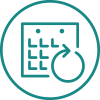
Renal Calculi

Renal Calculi
Purpose:
Renal stones (calculi), and renal stone disease (nephrolithiasis or urolithiasis), are a common problem worldwide with a prevalence of approximately 10% in men and 7% in women and an estimated 5-year recurrence rate of up to 50%. The prevalence of stones has been consistently increasing over the past 50 years and further increases are expected owing to changing lifestyle, dietary habits and global warming. Renal stones are associated with systemic diseases like Type 2 diabetes mellitus, obesity, dyslipidaemia, and hypertension. The costs associated with stone disease have also risen, increasing from an estimated US$2 billion in 2000 to over US$10 billion in 2006 in the US alone. Stone analysis plays a valuable role in the diagnosis of kidney stone patients, specifically in infrequently encountered kidney stones such as infection-induced, drug-induced, ammonia urate stones and in the rare cystine and xanthine inborn errors.
Scope:
The programme provides an independent assessment of the performance of calculi analyses in the laboratory. The aim is to ensure that participating laboratories clearly identify the chemical composition of calculi to avoid implementation of ineffective and, in some cases, life-changing treatments. In addition, by the inclusion of occasional rare sample types, the programme assesses whether laboratories recognise and act appropriately when faced with unusual samples.
The organic and inorganic chemicals used in the Programme are selected to mimic as closely as possible the clinical sample matrix (powdered stone form) and appropriate range of calculi constituents that laboratories would encounter. The sample matrices are combinations of pure chemical compounds (inorganic or organic) and an admixture of compounds. Each matrix is provided as a 100-150 mg of material. The programme consists of 6 rounds of testing events per year with each testing event consisting of four different “stone” matrices. Therefore 24 samples are analysed per year.
The chemical composition of the matrix and any admixtures are used as the target value. Although the ratio of composition is displayed and the results from the participants recorded, the percentage composition is not scored. The aim of the programme is to assess the ability of participants to correctly identify the compounds in the matrix.
Participants get 1 point for each sample component they correctly identify and lose 1 point for each component incorrectly identified. Each sample has a maximum score dependant on the number of compounds present.
The overall score for a distribution is the sum of all scores. E.g. for a matrix of Calcium Oxalate and Calcium phosphate mixture the correct score would provide a maximum score of 3 i.e. Calcium (1)+oxalate(1)+phosphate (1) = 3. For a matrix of uric acid alone, the maximum score would be 1. These scores are then translated using a scoring grid to Performance Indices (PI) to align with existing Weqas SDI scores (or Z scores). The well-established performance criteria based on Westgard rules used for other Weqas qualitative programmes are used to assign, good, acceptable, warning and poor comments to the report.
 |
Key Features:
|
| Renal Calculi* - Typical Samples Distributed |
|---|
| Calcium Oxalate (Monohydrate) |
| Calcium Oxalate |
| Calcium Phosphate (Brushite) |
| Calcium Phosphate (Hydroxyapatite) |
| Calcium Phosphate (Brushite) & Calcium Phosphate (Hydroxyapatite) |
| Calcium Oxalate (Monohydrate) & Calcium Phosphate (Hydroxyapatite) |
| Calcium Oxalate (Monohydrate) & Calcium Phosphate (Brushite) |
| Magnesium Ammonia Phosphate |
| Magnesium Ammonia Phosphate & Calcium Phosphate (Hydroxyapatite) |
| Uric Acid |
| Calcium Oxalate (Monohydrate) & Uric Acid |
| Calcium Phosphate (Brushite) & Uric Acid |
| Albumin |
| Cystine |
| Cystine & Calcium Phosphate (Brushite) |
| Cystine & Magnesium Ammonia Phosphate |
| Xanthine |
| Silicon Dioxide |
| Calcium Carbonate |
*Not Accredited
Related Documents








